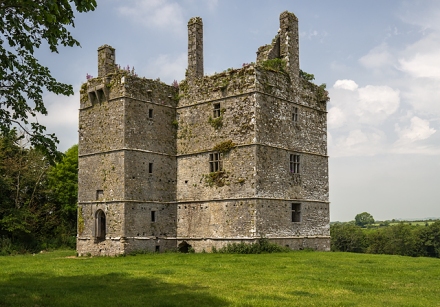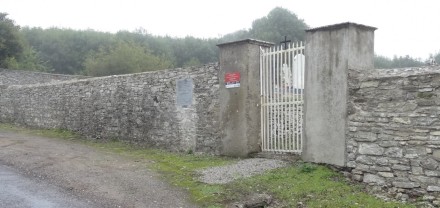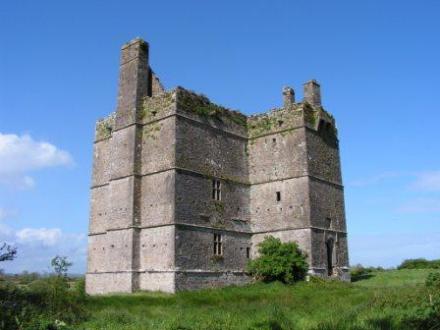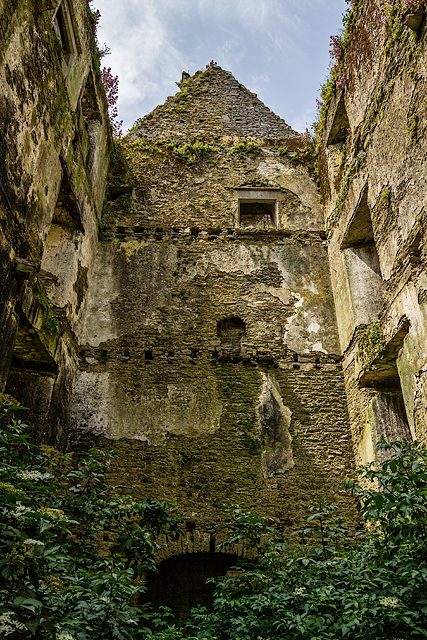
Ightermurragh Castle is a Stuart era ‘stronghouse’ built in 1641 by Edmund Supple and Margaret Fitzgerald ‘whom love binds as one.’ It remains one of the best preserved fortified houses in County Cork. The view shows the castle from the south-east, with the main entrance in the projecting wing. The original armorial over the door is long gone. Note the windows on the east wall, which gave a view of the formal garden.
In the barony of Imokilly, the local road R633 leads from Ladysbridge to Ballymacoda by way of the ancient parish of Ightermurragh. There is an old graveyard on the southern side of the road. Inside this enclosure there are scant remains of the seventeenth century church which stood there. There had been an earlier medieval chapel dedicated to the St Mary the Virgin which was subordinate to the College of Youghal. It seems likely that the chapel took its dedication from the Collegiate Church of St Mary at Youghal. However a new church seems to have been built following Ightermurragh’s erection as a separate parish in 1637. The creation of a separate parish with a new church at Ightermurragh was part of the attempt by the reformed Established Church to make a firm imprint on East Cork in the early seventeenth century. The nearby church of Kilcredan was also built in the early 1600s as perhaps the earliest purpose-built Protestant church in East Cork.

The small graveyard of Ightermurragh where the Protestant church erected in 1637 once stood.
This date is interesting because it suggests a link to the erection of a fortified house within sight – Ightermurragh Castle. What makes this juxtaposition so interesting is that although the church was built by the Established Church, the ‘castle’ was built by a man described as ‘Ir papist’ in the Down Survey. – the builder of the ‘very fayre large House’ was an Irish Catholic. The same Down Survey text says that the church was ‘demolished’. Even more interesting is the proximity of Ightermurragh Castle to the Fitzgerald’s Castle Richard (Inchinacrenagh) across the Womanagh River.which runs from west to east from near Cloyne to debouch into Youghal Bay near Ballymacoda.
With the most unfortunate timing, the fortified house at Ightermurragh was built in 1641 by the seemingly happily married Edmund Supple and his wife Margaret Fitzgerald ‘whom love binds as one‘ as proclaimed by the Latin inscription over the principal fireplace on the ground floor.
They built a four square three story block of rubble limestone with basement and attics. The main block runs east-west with a square, full height, central projection on the south front to house the arched entrance door. The north front is similar, but it housed the ‘back door’ or servant’s door at the foot of the wooden staircase that rose the full height of the building. The different floors are identified on the exterior by string courses. The windows are square stone mullioned openings of various sizes with hood mouldings. They are entirely typical of the early seventeenth century architecture of early Stuart Ireland.
The house had seven tall chimneys with corresponding fine fireplaces in various rooms of the house from the ground floor to the second floor. There was one oddity of Ightermurragh worth remarking on. When we build houses in Ireland today, we like to have the largest windows on the south west to capture the best of the day’s light. But when Edmund and Margaret built their new house, the best views were to the east over what appears to have been a walled garden. The entire west gable end was built without a single window. Indeed this end of the house consists of a huge chimney fed by the vast kitchen fireplace in the basement and by another fireplace on each of the first and the second floors.

Ightermurragh viewed from the south-west showing the entirely windowless west gable wall. This wall consists of a single great chimney. Note the box machicolation over the entrance door – and indication of the often unsettled conditions of early modern Imokilly.
Ightermurragh is the best preserved seventeenth century fortified house in East Cork. It lacks just the roof and the internal timber floors and partitions. Oh, and the leaded glass casements are gone from the stone-mullioned windows too.
In all, Ightermurragh must have been one of the best houses built in Imokilly before the Cromwellian invasion. It was clearly a modern, well built, well lit house with plenty of heating available from its numerous fireplaces. However Ightermurragh also looked backwards – it was a defended or fortified house. The principal entrance was protected by a ‘box machicolation’ on the parapet. This parapet ran all around the top of the house. There were holes for muskets to protect the entrance and other parts of the house. It should be recalled that there were no police to keep order when robbers attacked a dwelling.
Alas, Edmund Supple and his wife, Margaret Fitzgerald, had little time to enjoy their fine house. In 1642, the Great Catholic Rebellion had spread countrywide to all parts of Ireland….although Imokilly was relatively quiet until 1645. One night, Edmund, Margaret and their little child had to flee in the face of serious armed threats, presumably from the Protestant forces in Cork led by Lord Inchquin and Lord Broghill.
With the Cromwellian settlement of 1653, Roger Boyle, Lord Broghill who was now Lord President of Munster, awarded himself the Fitzgerald lands of Castlemartyr and also took for himself Ightermurragh. – the Ightermurragh holding was some 620 acres spread over five townlands.
With the Restoration in 1660, the Supples tried to recover their lands by a lawsuit. However, Boyle, now Earl of Orrery, was to entrenched to be moved.

The inner face of the west gable wall displays the huge kitchen fireplace (which has a bread oven) in the basement, with a small ruined fireplace on the first floor and a fine preserved fireplace on the second floor. Note the complete lack of windows on this wall.
By 1750 Ightermurragh was leased to a gentleman called Smith . He had a most unfortunate experience one night. Some robbers, apparently from Cloyne, got into the castle and began to threaten Smith to make him divulge his money. He gave was money he had in the house at the time but it wasn’t enough. It appears that Smith was really a farmer and not a particularly wealthy man. Failing to find any further money in their search of the house, the gang took Smith down to the kitchen. There they tied him to the spit in the huge fireplace – it was big enough to roast a whole ox. Smith was roasted over his own kitchen fire until the robbers were finally convinced that he had no more money in the house. With dawn approaching, the robbers grabbed their loot and fled into the darkness. Poor Smith finally got himself untied from the kitchen spit and, severely traumatised by his experience, fled to his relatives in Rathcoursey. It would seem that the robbers were never identified, caught or punished. It seems an appropriate story to recount at Halloween.
After this, Ightermurragh was abandoned although the Earl of Shannon, Boyle’s successor, did try to prevent the locals from looting the stonework in the later 19th century. Ightermurragh stands today as a gaunt reminder of how promise could turn sour in a very short time.




